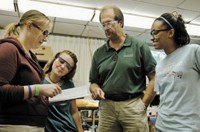Advertisement
Grab your lab coat. Let's get started
Welcome!
Welcome!
Create an account below to get 6 C&EN articles per month, receive newsletters and more - all free.
It seems this is your first time logging in online. Please enter the following information to continue.
As an ACS member you automatically get access to this site. All we need is few more details to create your reading experience.
Not you? Sign in with a different account.
Not you? Sign in with a different account.
ERROR 1
ERROR 1
ERROR 2
ERROR 2
ERROR 2
ERROR 2
ERROR 2
Password and Confirm password must match.
If you have an ACS member number, please enter it here so we can link this account to your membership. (optional)
ERROR 2
ACS values your privacy. By submitting your information, you are gaining access to C&EN and subscribing to our weekly newsletter. We use the information you provide to make your reading experience better, and we will never sell your data to third party members.
Education
Missed Opportunities
by Pamela Zurer, Deputy editor-in-chief
February 27, 2006
| A version of this story appeared in
Volume 84, Issue 9
We've all heard the story ofthe professor who greets his class at the start of the term with a threat: "Look to your left. Look to your right. By the end of the year, only one of you will still be here."
I've always been appalled by that story, apocryphal or not. What possible interests could it serve for an educator to flunk or frighten away more than half of the students?
I'm pretty sure that old story reflects a macho era that's faded away, and I hope there are no longer any chemistry professors who pride themselves on weeding out students through failure and intimidation. But even if academic chemists are not consciously trying to drive students away from studying chemistry, they are still managing to do so.
One recent example comes from within the C&EN family, which is why the disappointing quality of instruction in general chemistry is on my mind. Right now, three C&EN staff members have children in their first year in college. Only one signed up for introductory chemistry. And he has already quit, frustrated by a demanding course staffed by teaching assistants who speak English so poorly he was unable to get the help he needed.
This story makes me profoundly sad. Sad for the young man, because giving up on chemistry means he is also giving up a long-held dream of becoming a veterinarian. And sad for the chemical enterprise, because by making the introduction to our science a barrier rather than a welcoming gateway, we are squandering invaluable chances to attract new blood.
There is a huge captive audience of bright young minds in those introductory chemistry courses. Yet chemistry departments struggle to retain those students who started college with an interest in majoring in chemistry, much less recruit students who weren't considering chemistry in the first place. The community is missing the chance to capture those kids who sign up for freshman chemistry because they are premeds or engineering students or budding environmental scientists.
A recent report by ACS's Committee on Professional Training (CPT) summarizes a survey of enrollments in selected chemistry courses at 414 institutions (chemistry.org/education/cpt). In the 2003-04 academic year, CPT found, some 320,000 students at those schools enrolled in an introductory chemistry course, about 8% of the total undergraduate population. Further analysis by CPT indicates one in about 30 students taking general chemistry ends up a chemistry major, as do about one in nine taking organic chemistry and about half of those taking physical chemistry. The results underscore the vast opportunity available. Chemistry professors already have these kids' attention. Why aren't we bringing them into the fold?
I myself switched to a chemistry major on the basis of my freshman chemistry course. I started college as a classics major and took chemistry to fulfill a breadth requirement. Never having studied chemistry before, I struggled that first year. But the beauty of the discipline I was glimpsing fascinated me, and the small liberal arts college I attended wouldn't let me fail. Once I got immersed in organic, which became my passion, I was truly hooked.
Of the hundreds of chemists I've met in my career-first as a pharmaceutical industry researcher, then in grad school, and for the past 25 years at C&EN-I've never found another who came to the field the way I did. It's dangerous to extrapolate from a sample of one, but I find it telling that my experience is so unusual. Chemistry departments can't even seem to lure kids with a science bent, much less steal away those heading for the humanities or social sciences.
One hopeful development is the movement away from lecture courses toward inquiry-based models. ACS's general chemistry textbook, "Chemistry," embraces that approach. (See a rave review in C&EN, July 19, 2004, page 31.) Students using the text in field tests were more likely to go on to the second semester, enroll in organic, and think about being chemistry majors, according to the ACS Education Division's Jerry A. Bell, the chief editor. The key, Bell says, is to "aim at students who are actually in the course, not only those who we might hope are taking the course."
Chemistry departments should be aiming not to let any more would-be veterinarians slip away and perhaps even striving to capture the occasional classicist who wanders in.



Join the conversation
Contact the reporter
Submit a Letter to the Editor for publication
Engage with us on Twitter